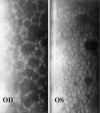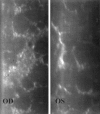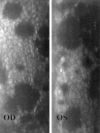Confocal microscopy in cornea guttata and Fuchs' endothelial dystrophy
- PMID: 10396196
- PMCID: PMC1722942
- DOI: 10.1136/bjo.83.2.185
Confocal microscopy in cornea guttata and Fuchs' endothelial dystrophy
Abstract
Aims: To report the appearances of cornea guttata and Fuchs' endothelial dystrophy from white light confocal microscopy.
Methods: Seven eyes of four consecutive patients with cornea guttata were prospectively examined. Of the seven eyes, three also had corneal oedema (Fuchs' dystrophy). In vivo white light tandem scanning confocal microscopy was performed in all eyes. Results were compared with non-contact specular microscopy.
Results: Specular microscopy was precluded by corneal oedema in one eye. In the remaining six eyes, it demonstrated typical changes including pleomorphism, polymegathism, and the presence of guttae appearing as dark bodies, some with a central bright reflex. In all seven eyes, confocal microscopy revealed the presence of round hyporeflective images with an occasional central highlight at the level of the endothelium. Changes in cell morphology and size were readily appreciated.
Conclusion: By comparison with specular microscopy, the hyporeflective images with an occasional central highlight seen on confocal microscopy are consistent with the presence of guttae. Confocal microscopy may confirm the diagnosis of cornea guttata and Fuchs' endothelial dystrophy by demonstrating the presence of guttae. This technique is especially valuable in cases of corneal oedema, where specular microscopy may fail to visualise the endothelium. However, specular microscopy should remain the method of choice to evaluate the endothelium, principally because it is easier to use.
Figures










References
Publication types
MeSH terms
Grants and funding
LinkOut - more resources
Full Text Sources
